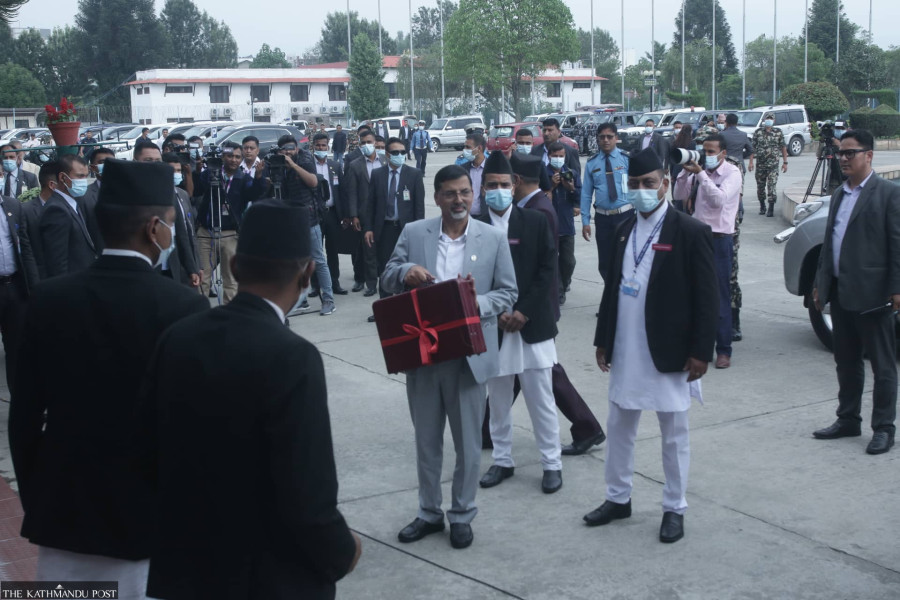National
Austerity is good but government has created more liability for itself
Costs for salary and pension of government staff and social security up by Rs76 billion for the next fiscal year as the ‘election-oriented’ budget focuses on populist schemes.
Prithvi Man Shrestha
The government’s seemingly contradictory policies—increasing the recurrent budget massively while promising austerity measures to control administrative costs—largely appear to be aimed at influencing the upcoming federal and provincial elections, experts say.
The two elections are due later this year after local polls were held last month.
According to the budgetary provision, the government has announced that it would reduce the government workforce by 10 percent in the fiscal year 2022-23. No new job openings will be announced in civil service and security services, according to the budget.
“Administrative cost of the government will be reduced by 15 percent,” it says.
The government has also made an announcement not to buy new vehicles in the next fiscal year.
The announcements are aimed at cutting costs. But it has increased the budget for recurrent expenditures massively, compared to the amount allocated for the current fiscal year.
Not only has the total budget under the recurrent heading increased but the share of recurrent budget also has risen compared to the budget for capital expenditure and that for financial management.
According to the budgetary provision, recurrent budget has increased to Rs753.40 billion from Rs677.99 billion for the current fiscal year.
The allocation for recurrent expenditure for the next fiscal year is 42 percent of the total budget compared to 41.52 percent in the current fiscal year.
“The government aims to be pupulist by bringing distributive programmes just as it has announced austerity measures ahead of the federal and provincial elections,” said Bidyadhar Maillk, a former minister and finance secretary.
Even though every government announces austerity measures, past experiences show that they are hardly implemented.
“There is a question whether the decision to trim the government workforce would be wise,” said Suman Sharma, a former finance secretary. “The reduction in the size of the workforce may also affect service delivery. So right-sizing the workforce is the right thing to do rather than downsizing it.”
Also, the government has decided to downsize the government workforce at a time when it will require more manpower for the upcoming elections.
Former top government officials also are not sure whether administrative expenses could be reduced as inflation is rising and the government should bear the cost of inflation in its procurement works.
“The government has decided not to buy new vehicles but it may have to buy them for the elections,” said Mallik.
Decreasing recurrent expenses is easier said than done. The government has been introducing measures for austerity time and again but they are not being fully implemented.
The 56th Annual Report of the Office of the Auditor General had detailed cases of violation of such measures by government agencies.
The government had introduced Austerity Guidelines on Public Expenditure-2018, which sought to control unwanted expenditures in procuring vehicles, fuel consumption and their maintenance. But in the fiscal year 2017-18, the government spent Rs6.61 billion on vehicle procurement.
As per the annual report, some ministries had a disproportionately high number of four-wheelers compared to the number of officer-level staff.
For example, the number of officer-level staff at the Home Ministry was 90 but there were 174 four-wheelers.
In October last year, the government came up with new austerity plans with measures related to reducing expenditure in the areas of vehicle procurement, fuel use, meetings, trips and other areas, but questions remain whether it would be implemented.
The previous KP Sharma Oli-led government had last year introduced Standards for Austerity in Public Expenditure-2020 to cut administrative expenses of the government.
“The problem with such standards is that one government introduces them and the next government does not heed them, so they are never implemented,” Netra Poudel, assistant spokesperson for the Office of the Auditor General, told the Post in October last year.
The new budget, however, talks about various austerity measures.
Through the budget for the next fiscal year, the government has created a long-term liability by increasing the salary of government employees by 15 percent, reducing the eligibility age for elderly social security allowance to 68 years from the previous 70 years, and announcing a “pension programme” for farmers under which the government would contribute 10 percent of farmers' total deposits to the programme.
These measures contribute to the rise of the overall recurrent expenditure for the next fiscal year. The government’s move to increase salary and reduce eligibility age for elderly allowance will create a liability of around Rs76 billion, according to the Finance Ministry.
The government has allocated Rs440.43 billion for salary, pension and social security for the next fiscal year, up from Rs364.44 billion in the current fiscal year.
The cost will rise by over 44 billion in salary and allowance for government employees and office bearers, according to the budget document. The government has allocated Rs188.74 billion for salary and allowance, up from Rs144.48 billion.
The government also announced expenses for social security at Rs131.89 billion while allocation for the current fiscal year stood at Rs127.78 billion.
“The government pushed the envelope of recurrent expenditure by increasing the salary and social security budget,” said Sharma. “Austerity measures announced in the budget alone will not be enough to reduce overall recurrent expenditure.”
According to Mallik, higher salaries mean higher pensions, and higher festive bonuses.
“So, the government is bearing more liability. The farmer pension plan will also increase long-term liability of the government,” he said. “I wonder why the government took such a decision of creating long-term liability. Is there a funding guarantee to sustain these schemes in the long run?”




 15.12°C Kathmandu
15.12°C Kathmandu















